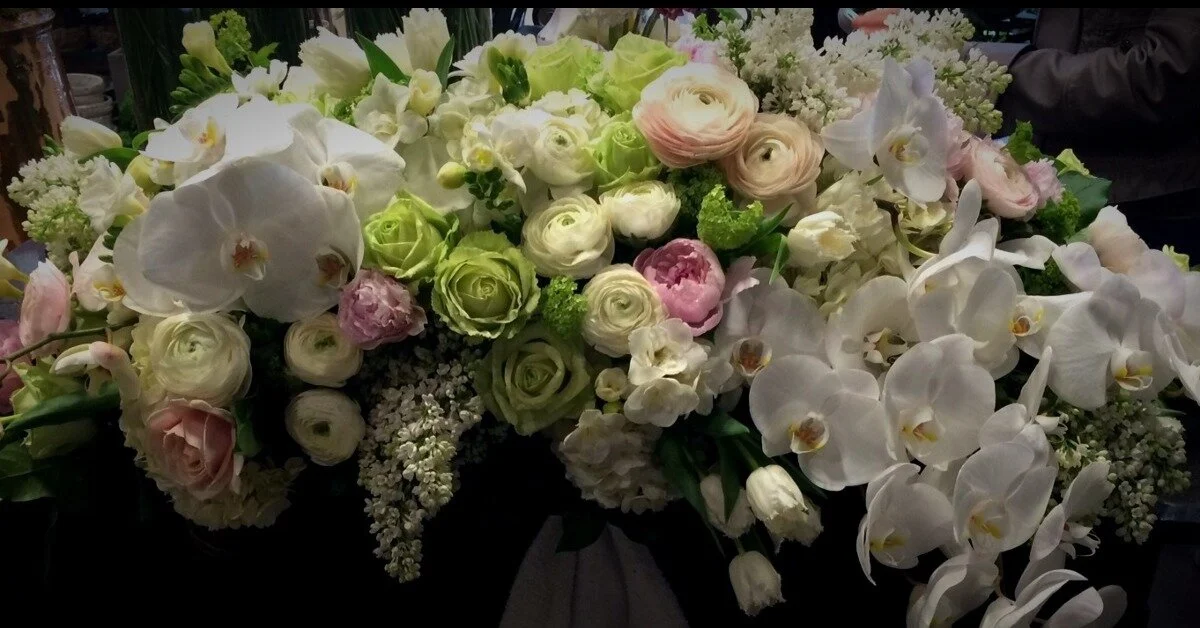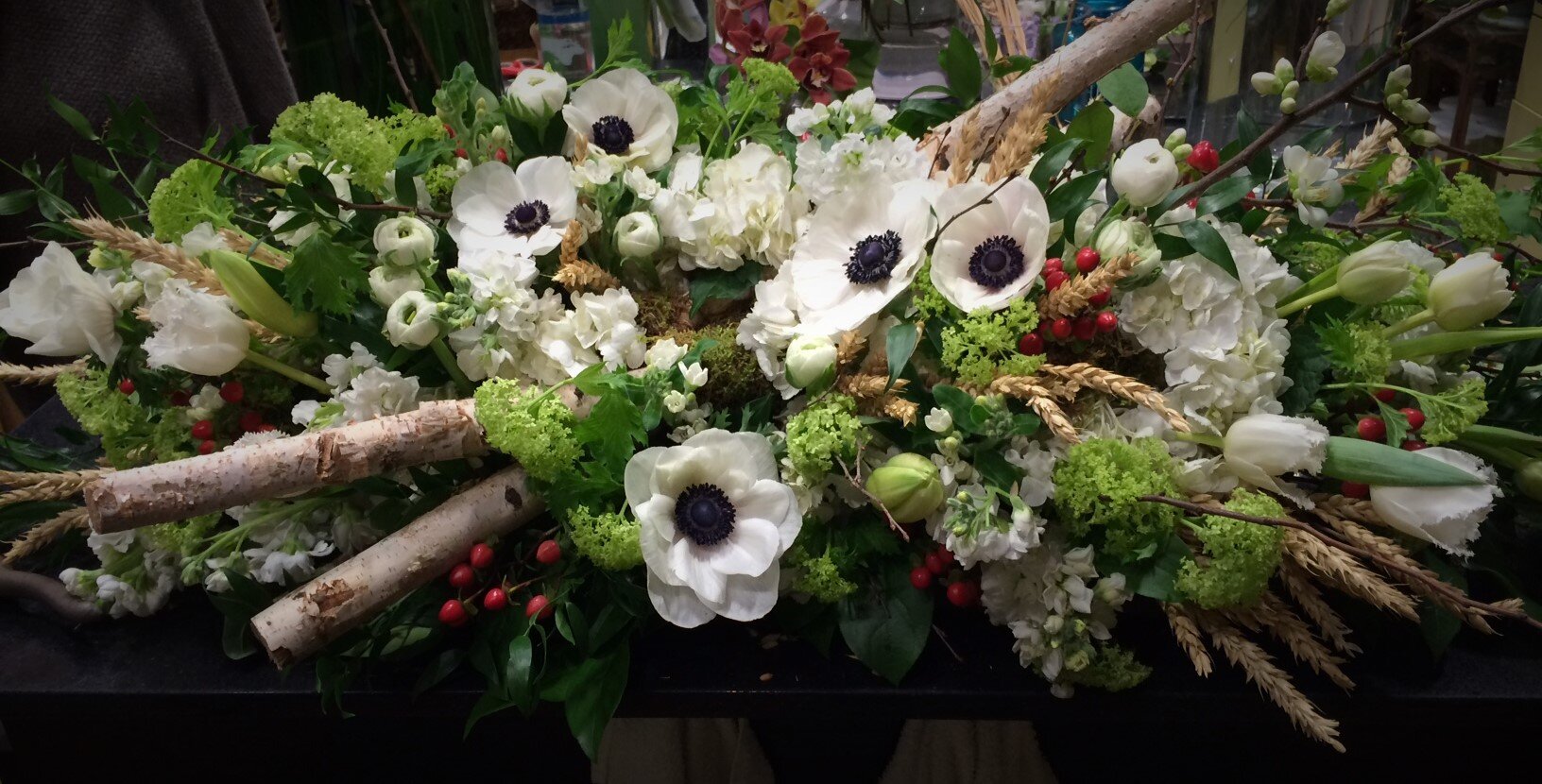Funeral Floral Design: Navigating Grief with Kindhearted Creativity
Designing funeral floral arrangements can be a challenge in many ways. In this article, you’ll discover practical tips and examples to help your clients navigate grief while honoring their loved one—all while infusing kindhearted creativity in your funeral floral designs.
Funeral Floral Arrangement Ideas: A Delicate Approach
There are many factors to consider with any floral arrangement: the colors or style requested by the client, their budget, and even understanding where the flowers will be placed. We even consider a client’s emotional state.
As floral designers, we have a unique opportunity to glimpse into client’s or family’s inner world. We see it when we design wedding flowers or in delivering a single arrangement to someone’s home or hospital bedside.
And this is also true of funeral arrangements.
“As floral designers, we have a unique opportunity to glimpse into client’s or family’s inner world. ”
It is this emotional state that can make designing funeral flowers a delicate (or even awkward) exchange with a client. We’re no longer navigating the emotional landscape of excitement or joy from a wedding or new baby; we’re now in a landscape of grief and overwhelm.
Rather than designing florals that feel as stiff or cold as an obligatory I’m sorry for your loss sentiment, this florist has learned that there’s room to stretch your creativity in kindheartedness—and, in turn, offer some comfort to a client.
By engaging with the deceased’s loved ones, it’s possible to connect with them and their inner world. We can use their memories to create designs, and we can design a family’s singular expression of honoring their loved one. Think of it as taking a loved one’s memory and translating it through the blooms and foliage.
Here are a few considerations on how to approach a funeral arrangement and capture your client’s memory.
Casket spray floral arrangement with birch trees, orchids, ranunculus, roses, and more
When Designing a Funeral Floral Arrangement, Let in Grief’s Discomfort
It can be easy to get swept up in a bride’s excitement when you first sit down to hear her ideas about what flowers and colors she’d like for her wedding.
However, when a client for a funeral piece calls or walks into your shop, there likely won’t be that same ease or eagerness of conversation. It might even be really uncomfortable. (I felt like a deer in the headlights the first time I spoke with a client ordering funeral flowers.)
Whether your tendency is to shut down or to wrap your arms around them, you can still strike a balance between staying professional and finding a genuine human connection that can feel comforting to your client.
Allow for Silences
“Whether your tendency is to shut down or to wrap your arms around them, you can still strike a balance between staying professional and finding a genuine human connection.”
Begin by taking a breath. Depending on the circumstances, allowing space for your client to cry or get choked up might be the best place to start.
Allow things to feel uncomfortable or awkward if that gives them time to catch their breath and compose their feelings. '
This also allows you a chance to gather your thoughts, prepare to take any notes, and read the room.
Call Them By Their Name
Make sure you get the name of the deceased loved one. Simply asking a client what the name of their loved one is can serve as a pressure valve.
Calling your client’s deceased loved one by their name is orienting for both your client and you. It also makes it a more personal experience for your client. They aren’t just another customer, and their loved one isn’t just another order.
“Calling your client’s deceased loved one by their name is orienting for both your client and you.”
Begin to Engage: Remember Them Together
From there, you may find that asking about their loved one’s personality or a memorable trait or story about them can serve both you, as the designer, and the client.
It’s likely that there wasn’t a great deal of forethought on what flowers a client would like for a funeral arrangement in the same way there would be for a wedding, so this is a great place to begin your own creative process or brainstorming.
If it’s appropriate, providing an example connected to a story—like the ones mentioned in the examples included below—may help your client know what would best honor their loved one. (But make sure to read the room; if it’s not emotionally appropriate to offer examples during the moment you’re in with your client, that’s okay.)
Example #1: a Personalized funeral floral arrangement honorIng a gardener
This bright orange altarpiece below was part of a trio of floral arrangements made for a gardener. His three children had come into the shop and described him as a “real character,” loving bright colors in his garden.
Listening and watching the siblings reflect and remember their father together was key for informing my creative decisions, like using shades of orange and peach and including blooms that might not traditionally show up in a funeral arrangement, such as fritillaria.
Explore Other Memories
Sometimes, asking about a loved one’s personality isn’t always the best route for gathering ideas or comforting the client.
Grief is complicated, and we can delicately lead our clients by asking for specific joyful memories or things that their loved one also loved.
They may be able open up more about other aspects of their loved one’s life or even their own life.
“Sometimes this can feel more like detective work than floral work.”
Sometimes this can feel more like detective work than floral work, but these context clues can lead to more creative designs and demonstrate your ability to be a good listener.
Listen Actively
Active listening is often associated with psychology, but it can be especially effective when having difficult or emotionally charged conversations.
“Active listening is a powerful tool for letting your clients feel heard and seen.”
Active listening is defined as “the process of listening attentively while someone else speaks, paraphrasing and reflecting back what is said, and withholding judgment and advice” (Cunic, 2020).
Stay mindful of your own verbal and nonverbal cues to show that you’re engaged throughout, even if emotions run high. Think of it as flexing empathy like a muscle, something that will definitely ease any tension in discussing funeral arrangements.
Active listening is a powerful tool for letting your clients feel heard and seen without taking on the role of therapist.
Example #2: a Personalized Funeral Floral Arrangement Inspired by The Romanian Countryside
This casket spray was for another client burying a father. The client described traveling with her father to his home country of Romania as a little girl. The birch trees and wheat fields stood out in her memory.
These seemingly small details felt poetic and became significant in this casket spray’s design. The flowers don’t have to represent the deceased loved one themselves, but can echo the experience of remembering them in a specific place or time.
Show, Don’t Tell
So what happens when you can’t get the client to open up about anything concrete to honor their loved one? Maybe it’s too painful, or perhaps they simply don’t know what to say.
There are about as many ways to grieve as there are flowers, so stay mindful of how your client responds to your questions.
“There are about as many ways to grieve as there are flowers.”
In these situations, try letting the flowers do the talking.
Often just showing the client the flower selection can offer both of you a little reprieve from any overwhelming feelings, and the client can point out specific blooms that capture something about their loved one they couldn’t articulate (a walk-in cooler can offer a literal cooling off for your client).
Clarity Can Comfort
You may not even speak with the deceased’s loved ones. In some cases, the funeral director may call you on the family’s behalf. This can alleviate any tension from an emotionally charged conversation, but you still want to put your active listening skills to use.
The key is to get as much information as you can on what the family is requesting for the flowers, so you minimize any miscommunication and streamline the whole process to make it easier on the clients.
Example #3: a Personalized Funeral Floral Arrangement that’s Soft and Feminine
Speaking with a client about her mother’s funeral flowers, she was simply at a loss. She didn’t want it to “look like funeral flowers” but wasn’t sure what else to say.
For this florist, that meant something soft, full, and had movement instead of the stiff symmetry often seen in traditional casket sprays. It meant something feminine, and it meant permission to go beyond the white and green color palette.
After walking the client through the cooler, she pointed out soft green roses as something to include. Even with little information to go on, you can still make connections that lend to your own creative process and reflect what your client wants.
You’re Loving the World Through Flowers—Even in Seasons of Grief for Your Clients
Losing a loved one can be the hardest thing to go through. It’s also a universal experience. Because it’s something we can all relate to in some capacity, you’ll be able to find ways to walk the line of being a sympathetic ear for your client and maintain your professionalism in getting the information you need to fill the order.
“Losing a loved one can be the hardest thing to go through. ”
These insights can help you walk that line so you don’t feel as though you’re walking on eggshells. It can also sharpen your active listening skills, which will serve you well regardless of what kind of floral arrangement you discuss with clients.
Use these considerations as signposts to guide you through grief honored in floral design. They can help you tune in to your own intuition when speaking with clients and reveal a new side of your own creativity—a kind of kindhearted creativity that offers solace.
References & Sources :
Cuncic, A. (2020, May 25). How to practice active listening. Very well mind. Retrieved on May 24, 2021. How to Practice Active Listening









